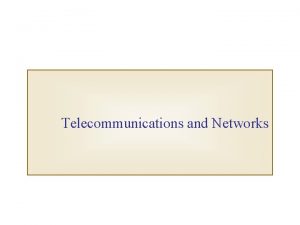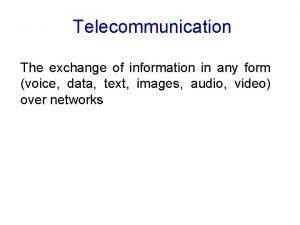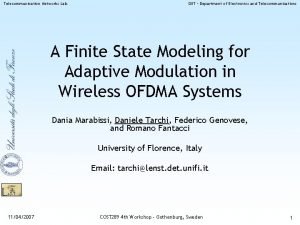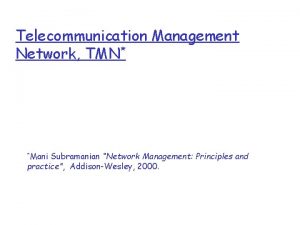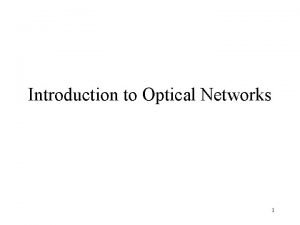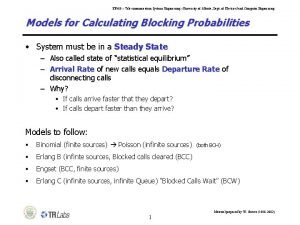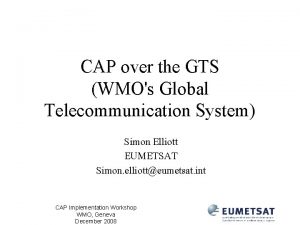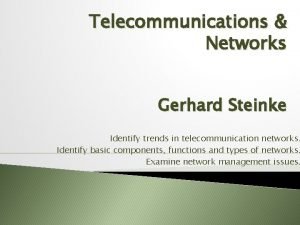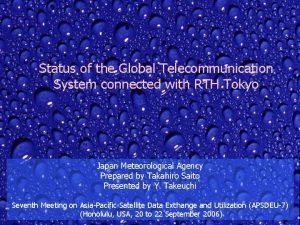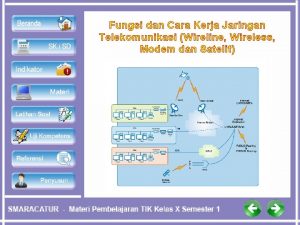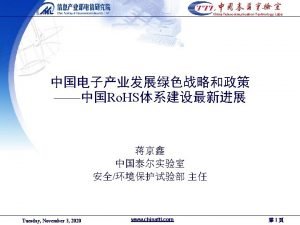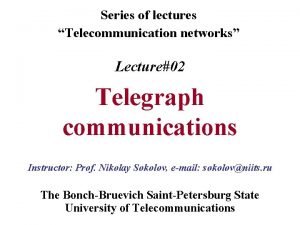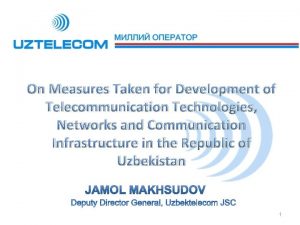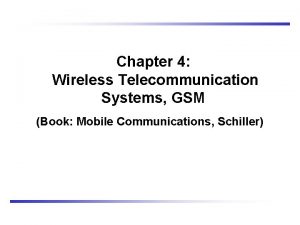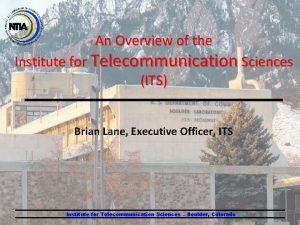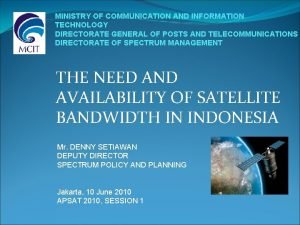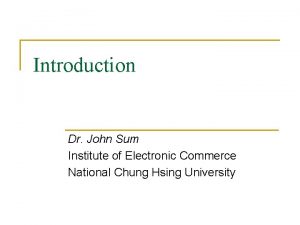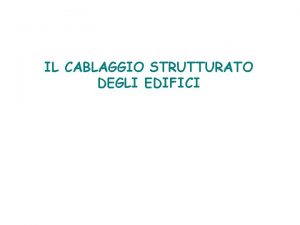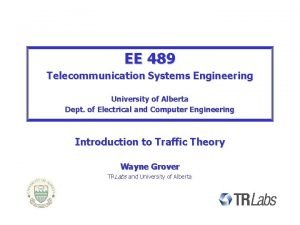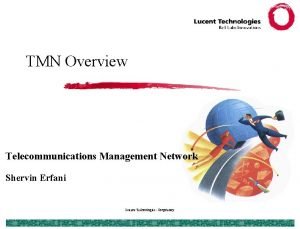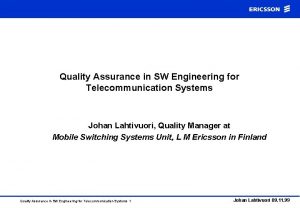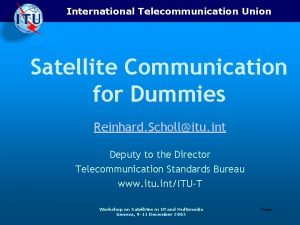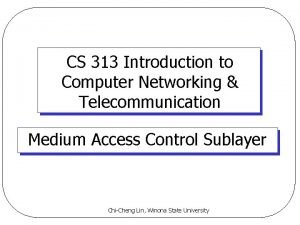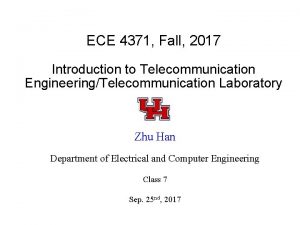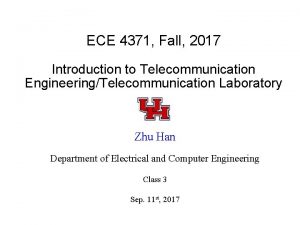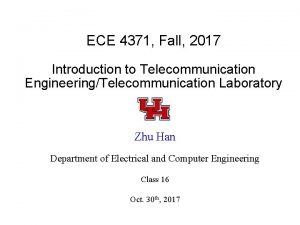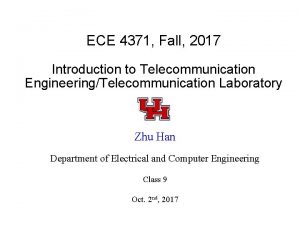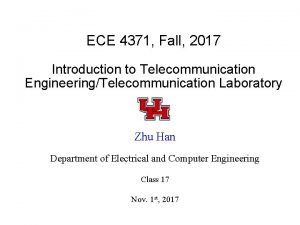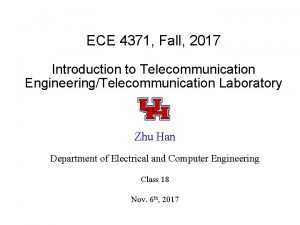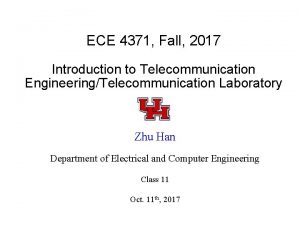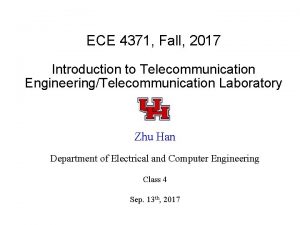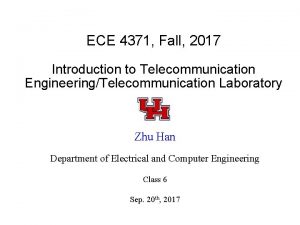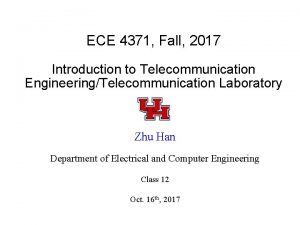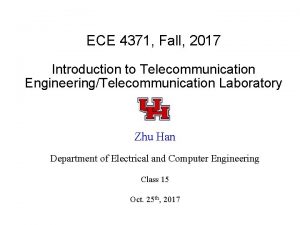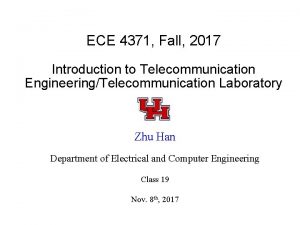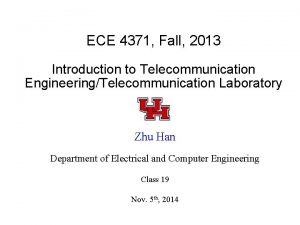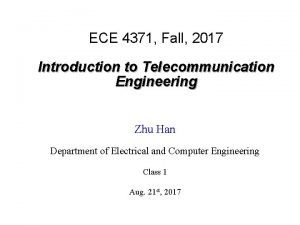ECE 4371 Fall 2017 Introduction to Telecommunication EngineeringTelecommunication





































- Slides: 37

ECE 4371, Fall, 2017 Introduction to Telecommunication Engineering/Telecommunication Laboratory Zhu Han Department of Electrical and Computer Engineering Class 13 Oct. 18 th, 2017

Outline l BER and Decision l Digital Carrier System – – – Carrier band vs. baseband Baud rate, bit rate, bandwidth efficiency Spectrum Coherent, noncoherent receiver BER Comparison l Homework 4 – 7. 2. 6, 7. 3. 4, 7. 4. 2, 7. 5. 1, 7. 7. 4, 7. 8. 1, Due 11/06/17 l 4117 Lab #4 and #5 11/8/17, l 4117 Lab #6 due at last class,

Bit Error Probability Noise d(i) We assume: g. Tx(t) na(t) g. Rx(t) • binary transmission with • transmission system fulfills 1 st Nyquist criterion • noise , independent of data source Probability density function (pdf) of Mean and variance

Conditional pdfs The transmission system induces two conditional pdfs depending on • if • if

Example of samples of matched filter output for some bandpass modulation schemes

Figure 5. 8 Illustrating the partitioning of the observation space into decision regions for the case when N 2 and M 4; it is assumed that the M transmitted symbols are equally likely.

Probability of wrong decisions Placing a threshold Probability of wrong decision When we define and as equal a-priori probabilities of and we will get the bit error probability s

Conditions for illustrative solution With and equivalently substituting for with

Special Case: Gaussian distributed noise Motivation: • many independent interferers • central limit theorem • Gaussian distribution é ù 1ê 2 ú 2 s = P 1 e d b ò ú 2ê 2 p s N 0 0 êë úû 2 2 N no closed solution Definition of Error Function and Error Function Complement

Error function and its complement l function y = Q(x) y = 0. 5*erfc(x/sqrt(2)); 2. 5 erf(x) erfc(x) 2 erf(x), erfc(x) 1. 5 1 0. 5 0 -0. 5 -1 -1. 5 -3 -2 -1 0 x 1 2 3

Bit error rate with error function complement Expressions with and antipodal: unipolar Q function

Bit error rate for unipolar and antipodal transmission l BER vs. SNR theoretical 10 -1 simulation unipolar -2 BER 10 antipodal 10 -3 10 -4 -2 0 2 4 6 8 10

Digital Carrier System Baseband analysis Signal in baseband: mean symbol energy: signal in carrier band: mean symbol energy: Conclusion: analysis of carrier band = base band. Fc=0 in project

Baud Rate, Bit Rate, Bandwidth Efficiency l Remember channel capacity C=Wlog 2 (1+ SNR)> fb

Power Spectrum, ASK l Baseband l Sy(W)=Sx(W) P(W) l ASK: Sy(t)=b Acoswct, Square wave convolute with sinusoid.

FSK Spectrum l FSK: two sinc added together

BPSK Spectrum l BPSK: Sx(W): NRZ. P(t): raised cosine function. Sy(W)= P(W) l Rb baud rate

QPSK Spectrum l Same Rb Narrow BW

Pulse Shaped M-PSK l Different

Bandwidth vs. Power Efficiency l Bandwidth efficiency high, required SNR is high and low power efficiency

QAM efficiencies l l For l =1 PSD for BPSK For l =2 PSD for QPSK, OQPSK … l PSD for complex envelope of the bandpass multilevel signal is same as the PSD of baseband multilevel signals l Same baud rate, higher bit rate. Same bit rate, less bandwidth. But higher power l

Minimum Shift Keying spectra l Continuous phase and constant envelop. So narrow spectrum

GMSK spectral shaping

Coherent Reception l An estimate of the channel phase and attenuation is recovered. It is then possible to reproduce the transmitted signal, and demodulate. It is necessary to have an accurate version of the carrier, otherwise errors are introduced. Carrier recovery methods include:

Coherent BER l PSK – BPSK – MPSK QPSK

Coherent BER performance l ASK l FSK l MSK: less bandwidth but the same BER l MQAM

Non-coherent detection l Non-coherent detection – does not require carrier phase recovery (uses differentially encoded mod. or energy detectors) and hence, has less complexity at the price of higher error rate. l No need in a reference in phase with the received carrier Differentially coherent detection – Differential PSK (DPSK) l l The information bits and previous symbol, determine the phase of the current symbol. Energy detection – Non-coherent detection for orthogonal signals (e. g. M-FSK) Carrier-phase offset causes partial correlation between I and Q braches for each candidate signal. The received energy corresponding to each candidate signal is used for detection.

Differential Reception

Differential Coherent l DBPSK l 3 d. B loss

Non-coherent detection of BFSK + - Decision stage:

Non-coherent detection BER l Non-coherent detection of BFSK Rayleigh pdf l Similarly, non-coherent detection of DBPSK Rician pdf

BER Example

Example of samples of matched filter output for some bandpass modulation schemes

Comparison of Digital Modulation

Comparison of Digital Modulation

Spectral Efficiencies in practical radios l GSM- Digital Cellular – Data Rate = 270 kb/s, bandwidth = 200 k. Hz – Bandwidth Efficiency = 270/200 =1. 35 bits/sec/Hz – Modulation: Gaussian Minimum Shift Keying (FSK with orthogonal frequencies). – “Gaussian” refers to filter response. l IS-54 North American Digital Cellular – Data Rate = 48 kb/s, bandwidth = 30 k. Hz – Bandwidth Efficiency = 48/30 =1. 6 bits/sec/Hz – Modulation: pi/4 DPSK

Modulation Summary l Phase Shift Keying is often used, as it provides a highly bandwidth efficient modulation scheme. l QPSK, modulation is very robust, but requires some form of linear amplification. OQPSK and p/4 -QPSK can be implemented, and reduce the envelope variations of the signal. l High level M-ary schemes (such as 64 -QAM) are very bandwidth efficient, but more susceptible to noise and require linear amplification. l Constant envelope schemes (such as GMSK) can be employed since an efficient, non-linear amplifier can be used. l Coherent reception provides better performance than differential, but requires a more complex receiver.
 Introduction of telecommunication
Introduction of telecommunication Njdv
Njdv Telecom risk management
Telecom risk management Objectives of telecommunication
Objectives of telecommunication Telecommunication information
Telecommunication information Means of telecommunication
Means of telecommunication Kyushu telecommunication network co.,inc.
Kyushu telecommunication network co.,inc. Telecommunication
Telecommunication Tmn functional architecture
Tmn functional architecture Society of worldwide interbank financial telecommunication
Society of worldwide interbank financial telecommunication In a telecommunications network architecture, a protocol is
In a telecommunications network architecture, a protocol is Telecommunication
Telecommunication Global telecommunication system
Global telecommunication system Telecommunication trends
Telecommunication trends Global telecommunication system
Global telecommunication system Itu world telecommunication indicators database
Itu world telecommunication indicators database Apa itu jaringan wireline ...
Apa itu jaringan wireline ... China telecommunication technology labs
China telecommunication technology labs Telecommunication
Telecommunication Telecommunication sealing technology
Telecommunication sealing technology Bsc and msc in telecom
Bsc and msc in telecom Institute for telecommunication sciences
Institute for telecommunication sciences World telecommunication standardization assembly
World telecommunication standardization assembly Txpdr
Txpdr Types of telecommunication networks
Types of telecommunication networks Telecommunication
Telecommunication Cablaggio verticale edifici
Cablaggio verticale edifici University of alberta
University of alberta Shervin taghavi
Shervin taghavi Telecommunication sealing technology
Telecommunication sealing technology Telecommunication system architecture with diagram
Telecommunication system architecture with diagram Quality control in telecommunication
Quality control in telecommunication Telecommunication sealing technology
Telecommunication sealing technology Telecommunication for dummies
Telecommunication for dummies Telecommunication medium
Telecommunication medium China telecommunication technology labs
China telecommunication technology labs Network management principles and practice
Network management principles and practice Telecommunication system architecture with diagram
Telecommunication system architecture with diagram



